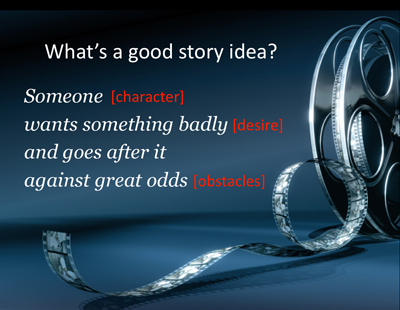In my previous post I revealed that, to craft a great (technical) presentation, I deliberately use storytelling techniques borrowed from contemporary screenwriting. I leverage the power of story to stimulate an emotional response, even a new behavior, in the audience.
This approach comes from the realization that, although important, rational thinking has its limits. Even if we have facts that prove that we are “right”, it doesn’t mean that people listen to us.
By framing a subjective point of view, however, a story can influence perceptions, reinterpreting and directing what those facts mean to our audience.
If you happen to believe that stories are just for entertainment, think again. Stories are powerful, even frightening, weapons of influence. They have been used for thousands of years to persuade masses to join religions and wars, to unite and divide, to discriminate between “right” and “wrong”.
I’m often told that storytelling is too difficult. Yet, we unconsciously tell stories to others and ourselves on a daily basis. We tell who we are, what we have done, what we value, etc. We strip out all the unnecessary details and use stories to package our experience, or the experience of others, for easy consumption.
Aristotle observed that traditional narrative is structured around a dramatic story told in 3 acts: beginning, middle, end. I was surprised to discover that, after thousands of years, Hollywood-style screenwriting is still firmly grounded around this structure.
In a future post I’ll examine it in more detail, but for now, I’ll just state the obvious: a good story starts with a good idea.
What’s a simple definition of a good story idea (to be told in 3 acts)?
Someone wants something badly and goes after it against great odds.
I learned this definition by heart (and I wish I could recall where I found it). This simple sentence embodies three key elements of a good story: Character (“someone”), Desire (“wants something badly”), and Obstacles (“and goes after it against great odds”).
Implicitly, this definition also elicits the dramatic question: “Will he/she succeed?”

I’m just scratching the surface here, but watch a movie tonight and see for yourself.
It might seem obvious, but the story ends when the answer to the dramatic question is revealed.
When I performed my “Agile Tales” presentation in Stockholm for the very first time last year, I distilled a story from my own experience. Back then I didn’t know anything about storytelling.
Coincidentally, I had a character (me), plenty of obstacles (IT project from hell), and strong desire (I didn’t want to fail!). It’s a classic case of something that works without knowing why!
The story was about overcoming obstacles using agility, effective communication, and deliberate creativity.
Early in the presentation, I explained that I was involved in this impossible IT project. All the odds were stacked against me.
The setup was excellent, wasn’t it? But then I said:
“Amazingly, project from hell was a success. Maybe this is why…”
Do you see what I did? I made a rookie mistake.
I resolved the dramatic question too soon, effectively releasing the tension I created.
Several months (and more than 50 screenwriting books) later, I said instead:
“Project from hell was threatening me. This is what I tried…”.
The facts were exactly the same, but I plotted the story differently. This simple modification allowed me to preserve the tension until the end.
Next time, I’ll continue this fascinating exploration into the world of storytelling by revealing a technique I learned from a two-time Pulitzer Prize winner.
Stay tuned.

I am staying tuned, eagerly awaiting the rest of the story. Don’t tell me this great series too got cancelled because of low ratings?! 🙂
Ah, thanks Joakim. Yay, somebody cares!…Actually the feedback was great and I do mean to go ahead with more posts. The reason for the huge delay is that, in the meantime, 1) I had a baby 2) More recently, I’m very busy doing Lean/Agile/Architecture consultancy work that is sucking most (all) of my time (but also leading to a great “Lean war story”).
I invested so much on exploring new avenues on how to develop presentations that it would be a shame not to share, however! These next few weeks are just crazy, but at some stage i will restart.
Hi Claudio,
Any news? I really love your advices, and I am intrested as well on how to create and deliver great presentations.
Hi Tiberiu, thanks so much for your comment. The good news is that I’m about to blog again, starting from where I left off.
Also, I just submitted a couple of proposals for Oredev, one of which is actually about creating these presentations using advanced screenwriting techniques (sort of “Mr Spielberg meets Presentation Zen”).
It is very original and hopefully it will be accepted although it doesn’t follow the typical standard tracks.
Hi Claudio, was at your presentation today and really enjoyed it. Very good and a great way to make people sit up and listen. I will be interested in your follow up blog.
Thanks for the feedback Michael. I’m doing some soul searching right now to see what directions to take.
Blog updates are imminent 😉
Hello Claudio–
Your presentation is Outstanding! Excellence reflects simplicity. Your presentation reflect simplicity.
It looks so easy to develop. Its like Wisdom and Truth…it too sounds so easy speak. We know it takes time, looking within ourselves with an open-heart and open-mind.
I wish you would teach an on-line course “Developing Storytelling Presentations.” I would sign up for it immediately.